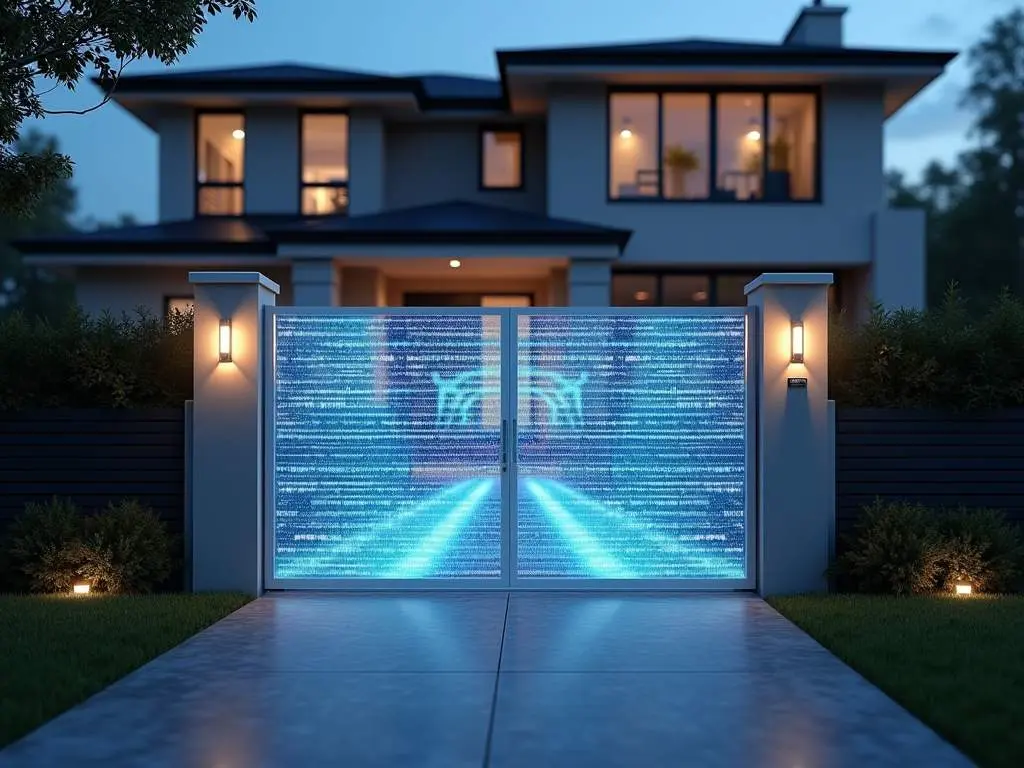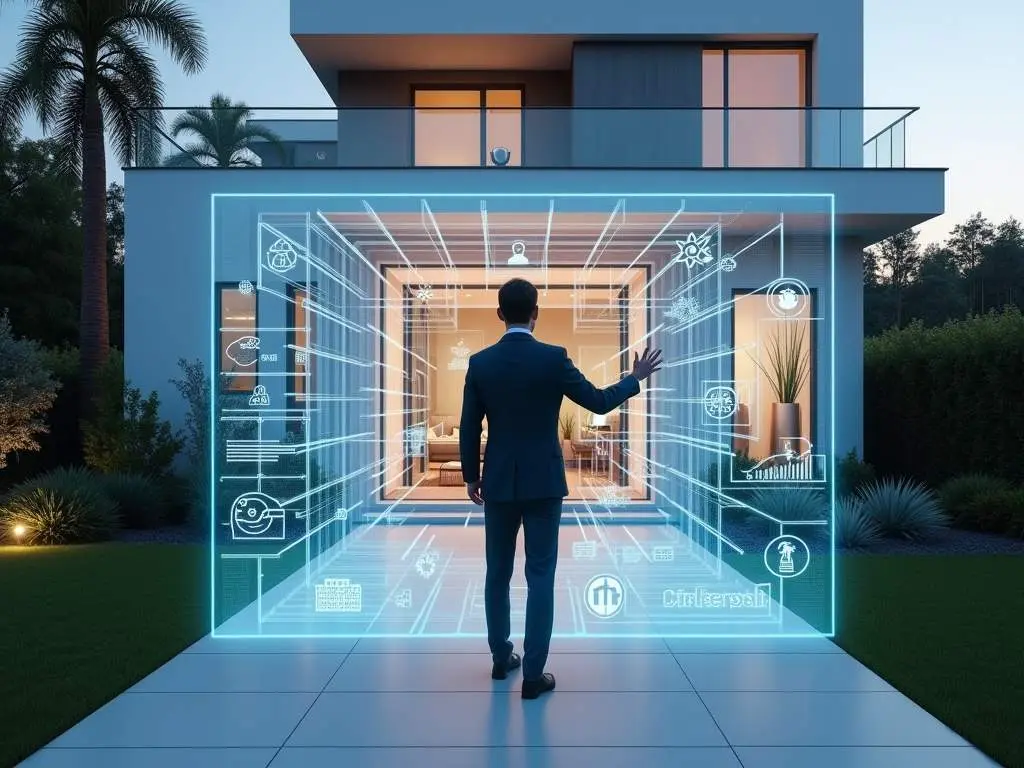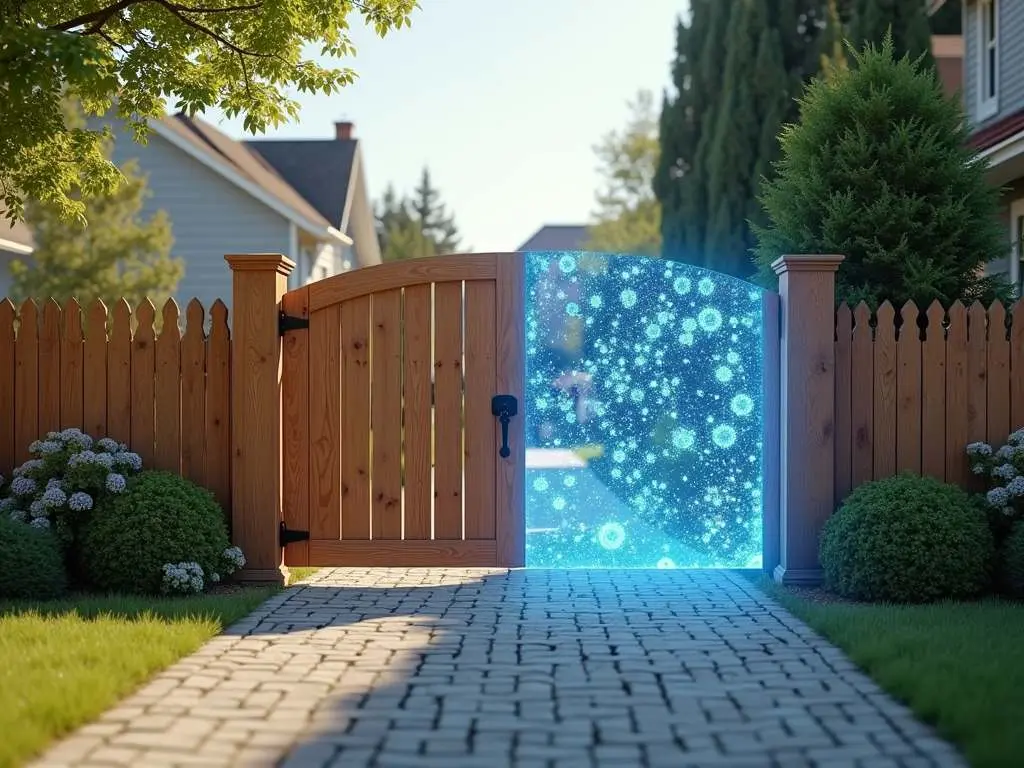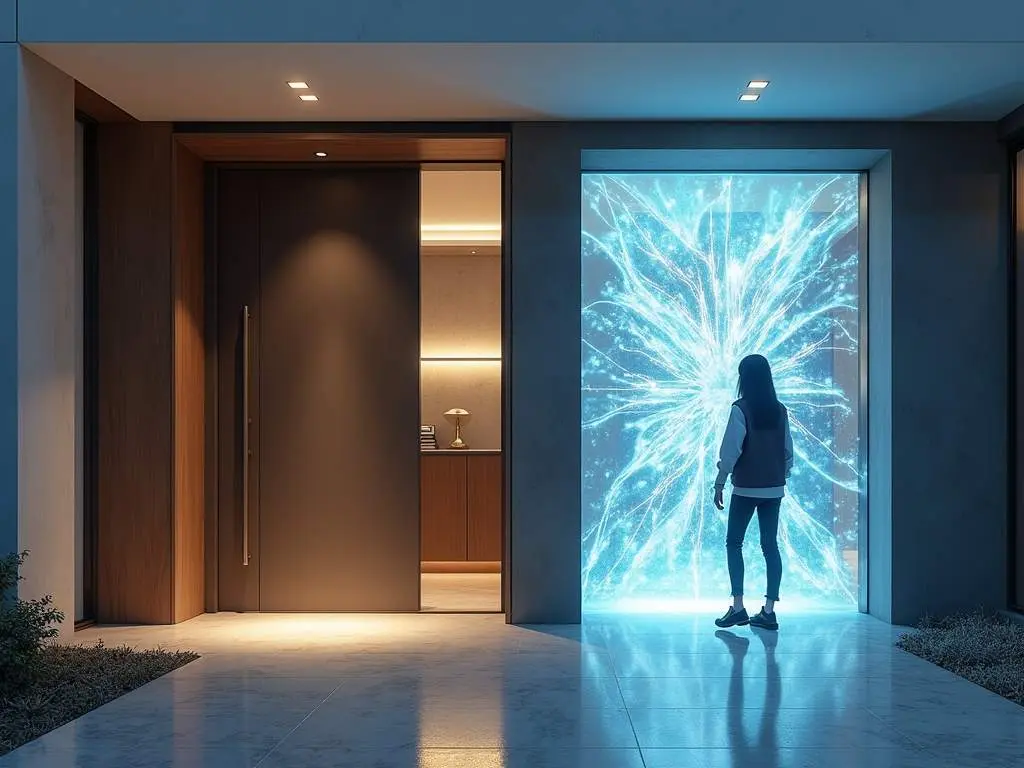As a futurist and technology consultant specializing in immersive experiences, I’ve been at the forefront of integrating holographic technology into architectural design. The fusion of digital illusions and physical spaces is revolutionizing how we perceive and interact with borders and entrances. In this article, we’ll explore the cutting-edge world of holographic gateways and their profound impact on design, security, and human experience.
Jump to:
The Evolution of Entrance Design

Entrances have always been more than mere thresholds; they’re statements of identity, transitions between worlds, and first impressions. From the grand arches of ancient Rome to the sleek glass doors of modern skyscrapers, entrance design has continually evolved to reflect societal values and technological capabilities.
But what if an entrance could be more than static architecture? What if it could shift, adapt, and communicate in real-time? This is where holographic technology enters the scene, blurring the lines between the tangible and the virtual.
The Rise of Holographic Technology
Holography, once the stuff of science fiction, has rapidly matured into a viable architectural tool. Unlike traditional projections, holograms create the illusion of three-dimensional objects or scenes floating in space, visible from multiple angles without special glasses.
Recent advancements in laser technology, spatial light modulators, and computer processing have dramatically improved the quality and scale of holographic projections. According to a study published in the journal Nature, researchers have developed holographic displays capable of projecting high-resolution, full-color 3D images visible in daylight conditions.
This technological leap has opened up new possibilities for architects and designers to reimagine how we define and experience borders and entrances.
Holographic Gateways in Action
Let’s explore some innovative applications of holographic technology in entrance design:
1. Dynamic Security Checkpoints
Imagine approaching an airport security checkpoint. Instead of fixed barriers and signs, you’re greeted by a shimmering holographic interface. As you approach, it recognizes you and displays personalized wayfinding information, security instructions, and even a friendly virtual assistant to guide you through the process.
This dynamic system can adapt in real-time to passenger flow, expanding or contracting virtual queues as needed. It can also instantly switch languages or display urgent alerts, enhancing both efficiency and safety.
2. Immersive Corporate Lobbies
Corporate headquarters are embracing holographic entrances to create memorable first impressions. A leading tech company in Silicon Valley has implemented a holographic lobby that showcases their latest products and innovations. Visitors walk through a tunnel of floating 3D prototypes, interactive data visualizations, and even holographic representations of key team members offering welcome messages.
This approach not only wows visitors but also serves as a powerful branding tool, immersing people in the company’s vision from the moment they step inside.
3. Adaptive Public Spaces
Urban planners are using holographic technology to create flexible, multi-use public spaces. In a park in Tokyo, holographic projectors create virtual gateways that transform the space throughout the day. During morning rush hour, they display transit information and news updates. In the afternoon, they shift to create playful entrance arches for children’s activities. At night, they become canvas for digital art installations, turning the park entrance into an ever-changing gallery.
4. Retail Reinvented
The retail sector is leveraging holographic entrances to blur the line between physical and digital shopping experiences. A high-end boutique in Paris has replaced its storefront with a holographic facade that can instantly change to showcase new collections, respond to weather conditions, or even interact with passersby through gesture recognition.
Inside, holographic product displays allow customers to visualize items in different colors or configurations before making a purchase, merging the convenience of online shopping with the tactile experience of in-store browsing.
The Technology Behind Holographic Gateways

To understand the potential and limitations of holographic gateways, it’s crucial to grasp the underlying technology:
Holographic Projection Systems
Modern holographic displays typically use one of two approaches:
- Volumetric Displays: These create true 3D images by illuminating points in space, often using rapidly rotating screens or stacked LCD layers.
- Light Field Displays: These simulate 3D images by projecting different views to each of the viewer’s eyes, creating a convincing illusion of depth.
Both systems require powerful computers to generate and render complex 3D scenes in real-time, as well as sophisticated optical systems to project the images accurately in space.
Interaction and Tracking
To create truly interactive holographic gateways, these systems are often paired with:
- Gesture Recognition Cameras: Allow users to interact with holograms using hand movements.
- Eye-Tracking Sensors: Adjust the holographic display based on the viewer’s perspective.
- Spatial Audio Systems: Create immersive soundscapes that complement the visual experience.
Environmental Considerations
Implementing holographic gateways in real-world environments presents unique challenges:
- Ambient Light Management: Holographic projections must be visible in varying light conditions, from bright sunlight to dim evening settings.
- Weather Resistance: Outdoor installations need to function reliably in rain, wind, and extreme temperatures.
- Power Efficiency: Large-scale holographic displays require significant energy, necessitating innovative power management solutions.
The chart above illustrates the rapid growth of the global holographic display market, reflecting the increasing adoption of this technology across various sectors, including architectural design and border control.
Implications for Design and Architecture
The integration of holographic technology into entrance and border design is prompting a fundamental rethinking of architectural principles:
1. Fluid Spaces
Holographic gateways challenge the notion of fixed architectural elements. Designers are now conceptualizing spaces that can transform on demand, adapting to different functions or aesthetic preferences without physical reconstruction.
2. Personalized Experiences
By integrating user data and AI, holographic entrances can offer tailored experiences for each visitor. This level of personalization was previously impossible with static architecture.
3. Sustainable Design
Holographic elements can reduce the need for physical materials in construction, potentially lowering the environmental impact of buildings. However, the energy requirements of these systems present new sustainability challenges.
4. Redefining Privacy
As entrances become more interactive and data-driven, architects and designers must grapple with new questions of privacy and data security in public spaces.
5. Accessibility Reimagined
Holographic interfaces offer new possibilities for creating universally accessible entrances, with the ability to adapt to different languages, visual abilities, and mobility needs in real-time.
Challenges and Considerations
While the potential of holographic gateways is immense, several challenges must be addressed:
Technical Hurdles
- Resolution and Brightness: Achieving convincing, daylight-visible holograms at architectural scales remains challenging.
- Power Requirements: Large-scale holographic systems consume significant energy, raising sustainability concerns.
- Maintenance: Complex projection systems require regular calibration and maintenance to ensure optimal performance.
User Experience
- Intuitive Interaction: Designing holographic interfaces that are immediately understandable to a diverse public is crucial.
- Avoiding “Hologram Fatigue”: As the novelty wears off, how do we ensure holographic elements continue to enhance rather than distract from the user experience?
Regulatory and Ethical Considerations
- Safety Standards: New regulations may be needed to ensure holographic entrances don’t create hazards or confusion in emergency situations.
- Data Privacy: As holographic systems collect and respond to user data, robust privacy protections must be implemented.
- Accessibility: Ensuring holographic interfaces are usable by people with various disabilities presents unique design challenges.
The Future of Holographic Gateways

As technology continues to advance, we can anticipate several exciting developments in holographic entrance design:
1. Haptic Feedback
Future holographic interfaces may incorporate mid-air haptic technology, allowing users to “feel” virtual objects and controls, further blurring the line between physical and digital.
2. AI-Driven Adaptation
Machine learning algorithms will enable holographic gateways to learn from user interactions, continuously optimizing the experience for efficiency and engagement.
3. Augmented Reality Integration
The line between holographic projections and AR overlays will blur, creating seamless transitions between physical, holographic, and augmented spaces.
4. Nano-Scale Holograms
Advancements in nanotechnology may lead to holographic surfaces at the material level, allowing entire building facades to become dynamic, holographic displays.
Case Study: The Stockholm “Digital Border” Project
To illustrate the real-world application of holographic gateway technology, let’s examine the innovative “Digital Border” project implemented at Stockholm’s Arlanda Airport in 2024.
Project Overview
The Swedish Transport Administration partnered with holographic technology firm LightField Labs to create a dynamic, adaptive border control system using large-scale holographic displays.
Key Features
- Holographic Queuing System: Virtual queue lines that expand or contract based on real-time passenger flow, optimizing space usage.
- Personalized Wayfinding: Holographic arrows and signs that guide individual passengers to the appropriate checkpoints based on their flight information and security status.
- Multi-Lingual Support: Instant language switching for information displays, accommodating international travelers without physical signage changes.
- Biometric Integration: Holographic interfaces that work in tandem with facial recognition and fingerprint scanning systems for seamless identity verification.
Results
After one year of operation, the Digital Border project reported:
- 30% reduction in average processing time per passenger
- 25% increase in space efficiency within the border control area
- 98% positive feedback from travelers on ease of navigation
This case study demonstrates the tangible benefits of holographic gateway technology in enhancing both operational efficiency and user experience in complex border environments.
People Also Ask
Q1. How do holographic gateways differ from traditional projection systems?
A. Holographic gateways create true three-dimensional images that appear to float in space and can be viewed from multiple angles without special glasses. Traditional projection systems display flat images on surfaces and lack the depth and interactivity of holographic displays.
Q1. Are holographic entrances safe for people with photosensitive epilepsy?
A. While holographic displays can be designed to minimize flashing effects, there is a potential risk for individuals with photosensitive epilepsy. Designers must follow strict guidelines for image refresh rates and content design to ensure safety. It’s recommended that holographic entrances include alternative, non-holographic pathways for those who may be sensitive to the displays.
Q3. How energy-efficient are holographic gateway systems compared to traditional lighting and signage?
A. The energy efficiency of holographic gateways varies depending on the specific technology used and the scale of the installation. While some holographic systems can consume more energy than traditional LED signage, advancements in laser technology and light-field displays are improving efficiency. Additionally, the multifunctional nature of holographic systems can potentially reduce overall energy use by replacing multiple traditional systems (lighting, displays, physical signage) with a single, adaptable solution.
Conclusion
Holographic gateways represent a paradigm shift in how we conceive and interact with entrances and borders. By merging the digital and physical realms, they offer unprecedented flexibility, personalization, and engagement. As the technology matures and challenges are addressed, holographic entrances will likely become an integral part of our built environment, reshaping our experiences of transition and boundary in profound ways.
References
1 Smalley, D. E., et al. (2018). A photophoretic-trap volumetric display. Nature, 553(7689), 486-490.
2 MarketsandMarkets. (2021). Holographic Display Market – Global Forecast to 2026. MarketsandMarkets Research Private Ltd.
3 International Hologram Manufacturers Association. (2023). The Future of Holography in Architecture and Design. IHMA Whitepaper Series.
Disclosure
Our content is reader-supported. This means if you click on some of our links, then we may earn a commission. Commissions do not affect our editor’s opinions or evaluations. Learn more about our editorial process.

About the Editorial Staff
The Curvspace editorial team comprises a diverse group of experts on intermediate and threshold spaces in homes and workplaces. Architects and interior designers, civil engineers and artists, environmental and behavioral psychologists, sociologists and anthropologists. All collaborate to create helpful content, that explores the full potential of these often-overlooked areas to enhance our daily lives.


